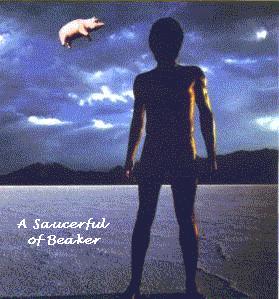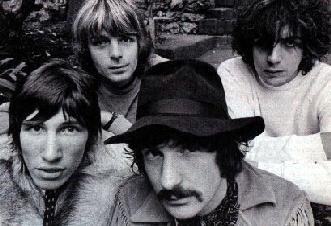Jagger and
Richard were
primary school friends who resumed their
camaraderie in their closing teenage
years after finding they had a mutual
love for R&B and particularly the music
of Chuck Berry , Muddy Waters and Bo
Diddley . Initially, they were teamed
with bassist Dick Taylor (later of the
Pretty Things ) and before long their
ranks extended to include Jones, Stewart
and occasional drummer Tony Chapman.
Their patron at this point was the
renowned musician Alexis Korner , who
had arranged their debut gig at London's
Marquee club on 21 July
1962.
In their first few months
the group met some opposition from jazz
and blues aficionados for their alleged
lack of musical 'purity' and the line-up
remained unsettled for several months.
In late 1962 bassist Bill Wyman (b.
William Perks, 24 October 1936,
Plumstead, London, England) replaced
Dick Taylor while drummers came and went
including Carlo Little (from Screaming
Lord Sutch 's Savages) and Mick Avory
(later of the Kinks , who was billed as
appearing at their debut gig, but didn't
play). It was not until as late as
January 1963 that drummer Charlie Watts
(b. 2 June 1941, London, England)
reluctantly surrendered his day job and
committed himself to the group. After
securing a residency at Giorgio
Gomelsky 's Crawdaddy Club in Richmond,
the Stones' live reputation spread
rapidly through London's hip
cognoscenti.
One evening, the
flamboyant Andrew Loog Oldham appeared
at the club and was so entranced by the
commercial prospects of Jagger's
sexuality that he wrested them away from
Gomelsky and, backed by the financial
and business clout of agent Eric Easton,
became their manager. Within weeks,
Oldham had produced their first couple
of official recordings at IBC Studios.
Unfortunately, pianist Ian
Stewart was not deemed sufficiently pop
star-like for Oldham's purpose and was
unceremoniously removed from the
line-up, although he remained road
manager and occasional pianist. After
supporting the Everly Brothers, Little
Richard, Gene Vincent and Bo Diddley on
a Don Arden UK package tour, the Stones
released their second single, a gift
from John Lennon and Paul McCartney
entitled 'I Wanna Be Your Man'. The disc
fared better than its predecessor
climbing into the Top 10 in January
1964.
That same month the group
enjoyed their first bill-topping tour
supported by the Ronettes .
The early months of 1964 saw the Stones
catapulted to fame amid outrage and
controversy about the surliness of their
demeanour and the length of their hair.
This was still a world in which the
older members of the community were
barely coming to terms with the Beatles'
neatly-groomed mop tops.

While
newspapers asked 'Would you let your
daughter marry a Rolling Stone?', the
quintet engaged in a flurry of recording
activity which saw the release of an EP
and an album both titled The Rolling
Stones. The discs consisted almost
exclusively of extraneous material and
captured the group at their most
derivative stage.
Already,
however, there were strong signs of an
ability to combine different styles. The
third single, 'Not Fade Away', saw them
fuse Buddy Holly 's quaint original
with a chunky Bo Diddley beat that
highlighted Jagger's vocal to
considerable effect. The presence of
Phil Spector and Gene Pitney at these
sessions underlined how hip the Stones
had already become in the music business
after such a short time. With the
momentum increasing by the month, Oldham
characteristically over-reached himself
by organizing a US tour which proved
premature and disappointing.
After returning to the UK, the Stones
released a decisive cover of the
Valentinos' 'It's All Over Now', which
gave them their first number 1. A
best-selling EP, 'Five By Five',
cemented their growing reputation, while
a national tour escalated into a series
of near riots with scenes of hysteria
wherever they played.
A return
to the USA saw them disrupt
the stagey 'Ed Sullivan Show', prompting
the presenter to ban rock 'n' roll
groups in temporary retaliation. In
spite of all the chaos at home and
abroad, America remained resistant to
their appeal, although that situation
would change dramatically in the New
Year. In November 1964, 'Little Red
Rooster' was released and entered the
New Musical Express chart at number 1, a
feat more usually associated with the
Beatles and, previously, Elvis Presley .
The Stones now had a formidable fan base
and their records were becoming more
accomplished and ambitious with each
successive release.
 Their early
efforts, 'It Should Have Been You' and
'Will You Be My Lover Tonight?' (both
recorded by the late George Bean) were
bland, but Gene Pitney scored a hit with
the emphatic 'That Girl Belongs To
Yesterday' and Jagger's girlfriend
Marianne Faithfull became a teenage
recording star with the moving 'As Tears
Go By'. 1965 proved the year of the
international breakthrough and three
extraordinary self-penned number 1
singles. 'The Last Time' saw them emerge
with their own distinctive rhythmic
style and underlined an ability to fuse
R&B and pop in an enticing fashion.
America finally succumbed to their spell
with '(I Can't Get No) Satisfaction', a
quintessential pop lyric with the still
youthful Jagger sounding like a
jaundiced roué.
Their early
efforts, 'It Should Have Been You' and
'Will You Be My Lover Tonight?' (both
recorded by the late George Bean) were
bland, but Gene Pitney scored a hit with
the emphatic 'That Girl Belongs To
Yesterday' and Jagger's girlfriend
Marianne Faithfull became a teenage
recording star with the moving 'As Tears
Go By'. 1965 proved the year of the
international breakthrough and three
extraordinary self-penned number 1
singles. 'The Last Time' saw them emerge
with their own distinctive rhythmic
style and underlined an ability to fuse
R&B and pop in an enticing fashion.
America finally succumbed to their spell
with '(I Can't Get No) Satisfaction', a
quintessential pop lyric with the still
youthful Jagger sounding like a
jaundiced roué.
Released in
the UK during the 'summer of protest
songs', the single encapsulated the
restless weariness of a group already
old before its time. The distinctive
riff, which Keith Richard invented with
almost casual dismissal, became one of
the most famous hook lines in the entire
glossary of pop and was picked up and
imitated by a generation of garage
groups thereafter. The 1965 trilogy of
hits was completed with the engagingly
surreal 'Get Off Of My Cloud' in which
Jagger's surly persona seemed at its
most pronounced to date. As well as the
number 1 hits of 1965, there was also a
celebrated live EP, 'Got Live If You
Want It', which reached the Top 10 and,
The Rolling Stones No.2 that continued
the innovative idea of not including the
group's name on the front of the sleeve.
There was also some well documented bad
boy controversy when Jagger, Jones and
Wyman were arrested and charged with
urinating on the wall of an East London
petrol station.
'Out of Time'
was another chart-topper. Ever
outrageous, the group promoted the
record with a photo session in which
they appeared in drag, thereby adding a
clever, sexual ambivalence to their
already iconoclastic public image.
1967 saw the Stones' anti-climactic
escapades confront an establishment
crackdown. The year began with an
accomplished double a-sided single,
'Let's Spend The Night Together'/'Ruby
Tuesday' which, like the Beatles' 'Penny
Lane'/'Strawberry Fields Forever',
narrowly failed to reach number 1 in
their home country.
The
revitalization of the Stones was
demonstrated in the early summer of 1968
with 'Jumpin' Jack Flash', a single that
rivalled the best of their previous
output. The succeeding album, Beggars
Banquet, produced by Jimmy Miller, was
also a return to strength and included
the socio-political 'Street Fighting
Man' and the brilliantly macabre
'Sympathy For The Devil', in which
Jagger's seductive vocal was backed by
hypnotic Afro-rhythms and dervish yelps.
While the Stones were
re-establishing themselves, Brian Jones
was falling deeper into drug abuse. A
conviction in late 1968 prompted doubts
about his availability for US tours and
in the succeeding months he contributed
less and less to recordings and became
increasingly jealous of Jagger's leading
role in the group.
In June 1969
Jones officially left the group. The
following month he was found dead in the
swimming pool of the Sussex house that
had once belonged to writer A.A. Milne.
The official verdict was 'death by
misadventure'. A free concert at
London's Hyde Park two days after his
death was attended by a crowd of 250,000
and became a symbolic wake for the
tragic youth. Jagger released thousands
of butterflies and narrated a poem by
Shelley for Brian. Three days later,
Jagger's former love Marianne Faithfull
attempted suicide. This was truly the
end of the first era of the Rolling
Stones.
The group played out
the last months of the 60s with a
mixture of vinyl triumph and further
tragedy. The sublime 'Honky Tonk Women'
kept them at number 1 for most of the
summer and few would have guessed that
this was to be their last UK chart
topper. However, the Stones were singing
out the 60s to the backdrop of a Hells
Angels' killing of a black man at the
Altamont Festival in California. The
tragedy was captured on film in the
grisly 'Gimme Shelter' movie released
the following year. After the events of
1969, it was not surprising that the
group had a relatively quiet 1970.
The group's playful
fascination with sex was further
demonstrated on the elaborately designed
Andy Warhol sleeve which featured a
waist-view shot of a figure clad in
denim, with a real zip fastener which
opened to display the lips and tongue
motif that was shortly to become their
corporate image. Within a year of Sticky
Fingers, the group returned with a
double album, 'Exile On Main Street'.
Even through the short-lived 'punk rock'
era of the early '80's, The Stones held
their own and put out new
material.
After nearly 30 years
in existence, the Rolling Stones began
the 90s with the biggest grossing
international tour of all time, and
ended speculation about their future by
reiterating their intention of playing
on indefinitely. Certainly, their fan
base remains huge and successive
generations have joined the sold-out
crowds who continue to come see Mick and
the boys and the dynamism of the Rolling
Stones.




 Gilmour in the
'70's!
Gilmour in the
'70's!
